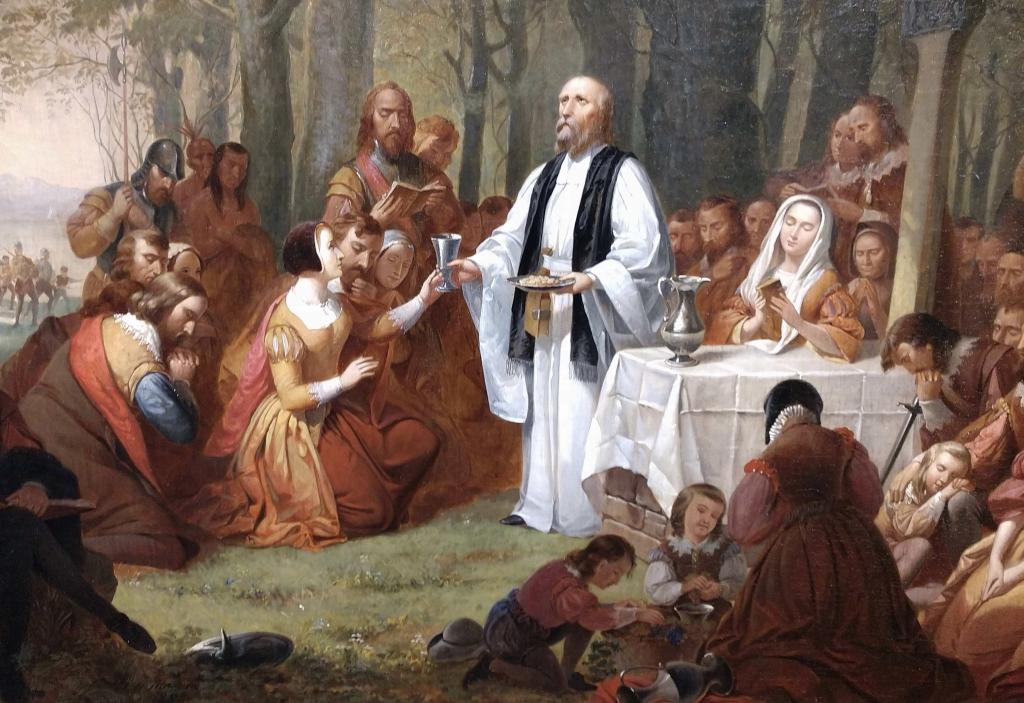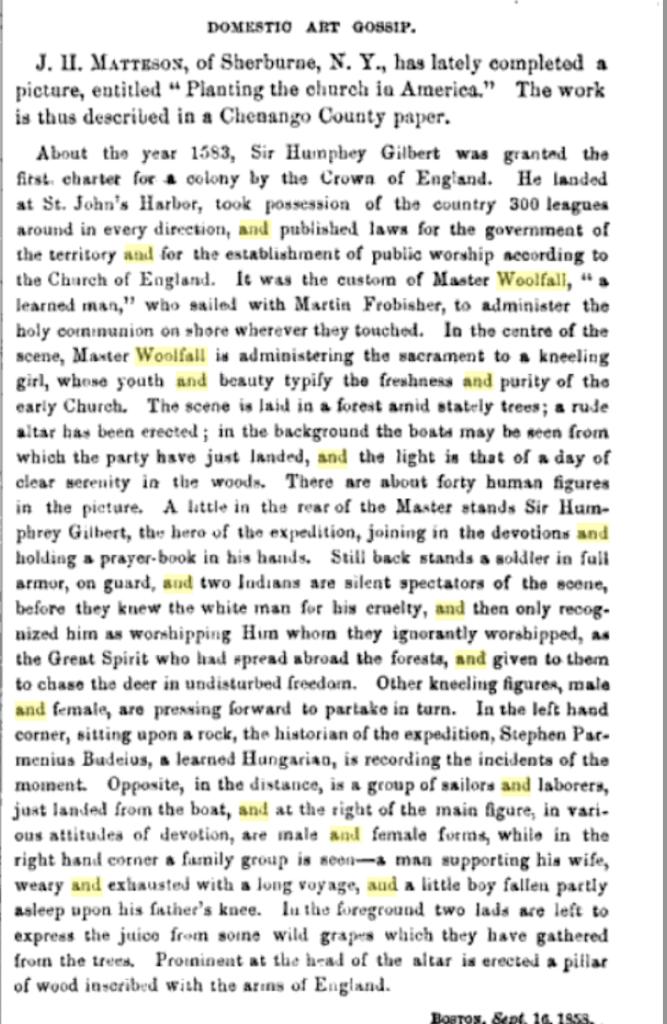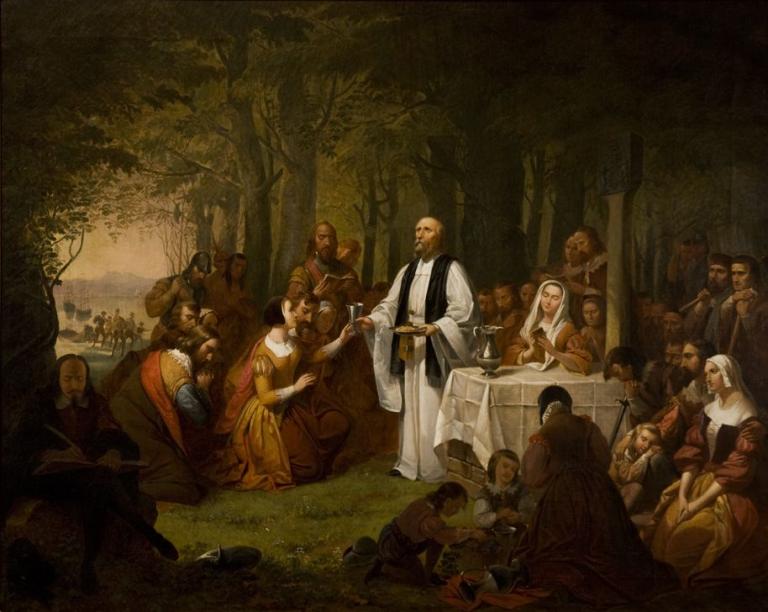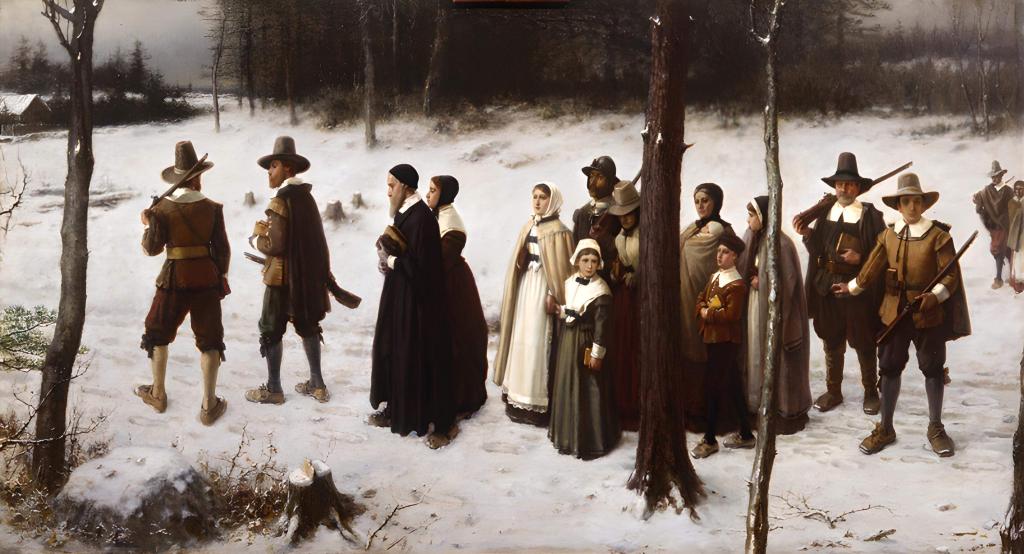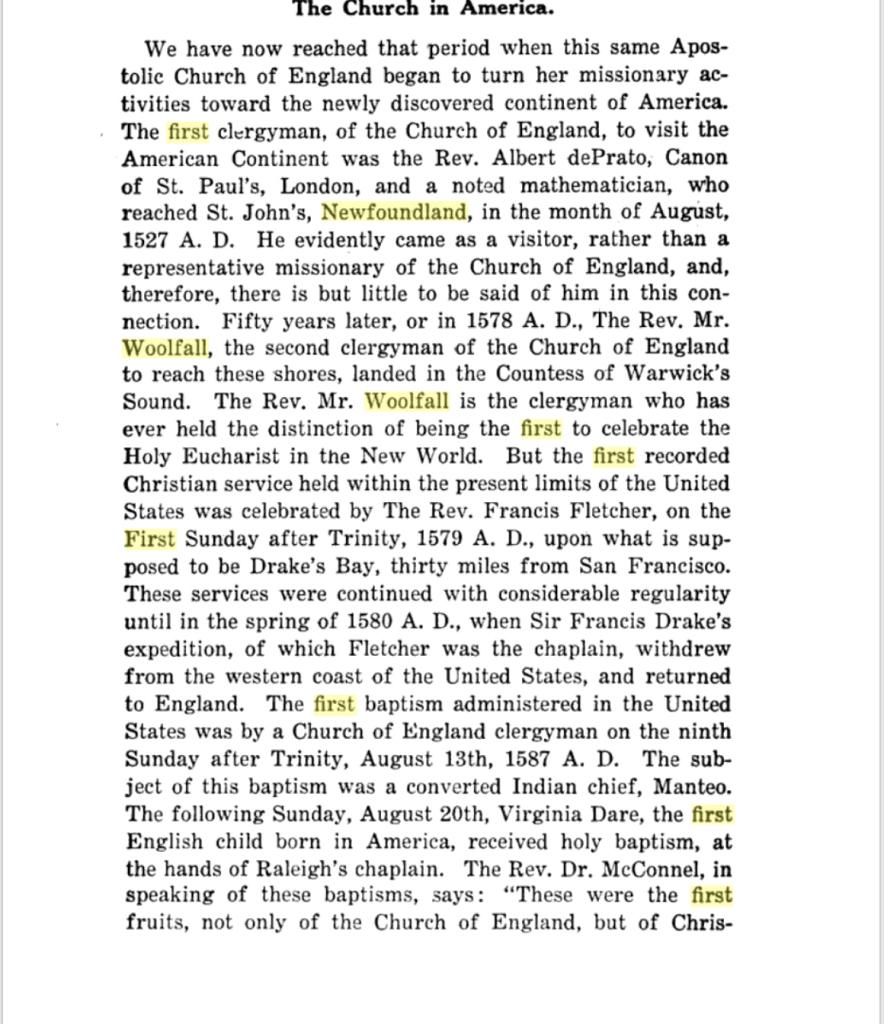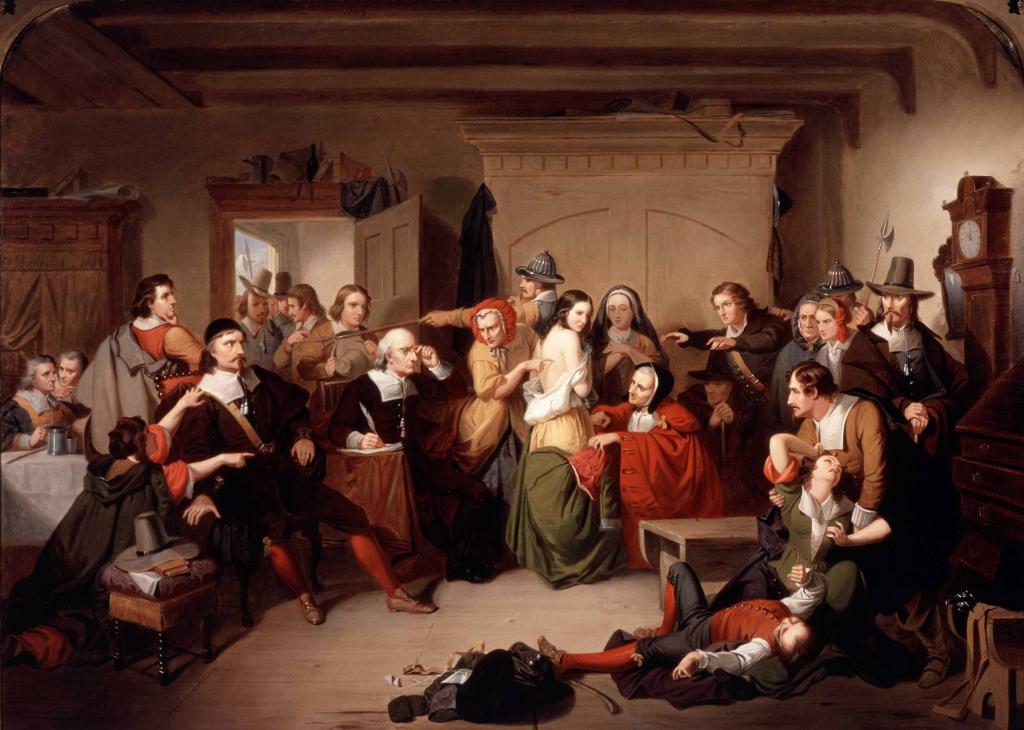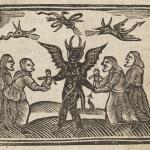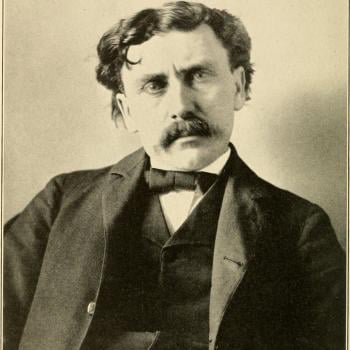I am presently revising my textbook on the History of the United States, for a sixth (!) edition. Through the span of American history, certain themes surface repeatedly, even obsessively, and among those is the nature of the country’s founding: what exactly were the foundations and values on which it was built? Godly and Puritan? Secular and Enlightenment? Slave-holding or free? Of the country’s nature, such historical debates have always resonated in political debate, and they continue to do so. Each generation fights its History Wars anew.
In mid-nineteenth century America, Tompkins Harrison Matteson (1813-1884) was a popular painter and illustrator, one of New York’s most celebrated artists. He chose as his subjects the famous and canonical moments of the young nation’s history – such events as the Salem witch trials, the first Continental Congress, or Washington at Valley Forge, together with scenes from best-sellers by Nathaniel Hawthorne and James Fenimore Cooper. Through endless reproductions in textbooks, such works did much to create the popular visual image of that early America. In 1858, Matteson painted a work that is now all but forgotten, but which tells us a great deal about the History Wars as they were conducted in that particular era. The work richly illuminates the history in that era of the Episcopal Church, which then played a role in national life far greater than its crude numbers might suggest.
The Painting
The painting in question is presently known as “First Communion in the New World.” (I am being deliberately ambiguous about the original title). It is found in the Palmer Museum of Art at the main campus of Penn State University. I note in passing that that museum is currently undergoing a move to a handsome new home on that campus, so the painting will not be visible for some months.
The best original description of the work comes from the art magazine The Crayon: A Journal Devoted to the Graphic Arts and the Literature Related to Them, vols. 5-6 (1858), 296. Here is the full text:
Do note the alternate and, perhaps, the original title offered here, which is “Planting the Church in America.”
As it stands, this account of Matteson’s painting conflates and confuses two reasonably well documented events. Woolfall served on two expeditions, Martin Frobisher’s in 1578, and Humphrey Gilbert’s in 1583. The first Anglican Communion in the New World occurred in 1578, in Hudson’s Bay. The Gilbert event depicted here, which occurred in Newfoundland, was therefore not the first, and Matteson might have made a simple error. More probably, he chose the later event because it offered the opportunity to depict civilian settlers who looked more like the popular stereotypes of early New England, rather than the very icy landscapes that Frobisher would have known. Matteson is consciously trying to offer a counter to the Pilgrim mythology.
The description of the work in the modern Palmer Museum summarizes that Crayon account, and adds the comment that “Its focus on the spread of the Church of England in the New World may be understood as part of a search for early American political and religious roots amid the turbulence of the 1850s.” Dating as it does before the settlement of Jamestown (1607) and Plymouth (1620), it “likely tapped into Anglo-American Protestant anxieties amid the massive influx of Irish Catholic immigrants into the United States during the mid-nineteenth century.” Well, maybe, but there is a much more direct set of issues at stake here, and these are essential to understanding the work’s intent and significance. The core themes involve tensions not between Catholics and Protestants, but between different Protestant sects and denominations.
History Wars
Colonial history was a common weapon in nineteenth century America, and especially in the growing schism between north and south. Daniel Webster in particular played a notable role in mythologizing the early achievements of New England, and giving inordinate significance to such emerging icons as Plymouth Rock and the first Thanksgiving. In this view, American history began in Puritan New England, and not in the aristocratic and slave-owning Middle Colonies or the South. Plymouth trumped Jamestown.
From the 1830s, writers like Nathaniel Hawthorne and John Greenleaf Whittier vigorously reinforced this idea, and it was in these years that the Salem trials (for instance) became such a fundamental part of national mythology. Hawthorne produced his The Scarlet Letter in 1850, with House of the Seven Gables in 1851. That Puritan and New England theme became ever more stressed after the Civil War. It was in 1867 that George Henry Boughton painted the much-reproduced image of Puritans walking through the snow to their service, with the pastor bearing the Bible.
Episcopal America
But if America had its true roots in the Puritans, the ancestors of later Congregationalists, where did that leave other denominations, and especially the Episcopalians? In the mid-nineteenth century, Baptists and Methodists were by far the most popular and successful American denominations, but the Episcopal Church remained oddly visible and prestigious. To take one example, in a country without an established church, Episcopalians dominated military chaplaincies. In 1850, Herman Melville’s White Jacket reported the story of a Baptist seaman who complained about his chaplain:
“Sir, I am a Baptist; the chaplain is an Episcopalian; his form of worship is not mine; I do not believe with him, and it is against my conscience to be under his ministry. May I be allowed, sir, not to attend service on the half-deck?”
“You will be allowed, sir!” said the Captain, haughtily, “to obey the laws of the ship. If you absent yourself from prayers on Sunday mornings, you know the penalty.”
When Abraham Lincoln sent a three man delegation to England in 1861 to beg the British not to recognize the Confederacy, one of the envoys was the prominent Bishop of Ohio, Charles McIlvaine. Even in the 1890s, the US commissioned its long sought great building for national events and celebrations, which was originally and firmly specified to be non-sectarian. It became Washington’s (Episcopal) National Cathedral, which it remains.
Matteson and Hale
Matteson himself was an Episcopalian, whose grave can be seen in Christ Episcopal Church in Sherburne, NY. A critical influence in his life was Benjamin Hale of Newburyport (1797-1863), a distinguished member of the same church, who represented its very high faction.
Originally a Congregational minister, Hale developed a passionate belief in what he termed “The Apostolicity of Episcopacy.” Dartmouth College hired him as a Professor in 1827, but he joined the Episcopal Church, becoming a deacon in 1828 and a priest in 1831. He held private meetings and services in his home, which infuriated Congregational clergy and administrators. In 1835, Dartmouth removed him, not technically by firing him but by abolishing his position, thereby generating a wide-ranging controversy over academic free speech and religious self-expression. From 1836 through 1858, Hale served as President of Hobart College.
Crucially, it was Hale who gave Matteson the life-changing advice that he should concentrate on patriotic and historical paintings, which he did with enormous commercial success.
Claiming American Roots
As I have suggested, Matteson’s painting was a riposte to Puritan claims to be there first. He was in no way denigrating the Puritans, whom he admired immensely, to the point of wearing a kind of neo-Puritan costume in daily life. But he was seeking to bring his own Episcopal church back into the national conversation. The painting offers a simple reminder that the Anglican/Episcopal church was deeply rooted in North America, and this was in fact the origin of “the Church” in this continent. According to taste, that could be taken to refer to the Anglican church, or to the Christian church as a whole. Either way, this was an Anglican triumph, long before the Congregationalists.
In reality, it should be said, the first actual mass in what became the United States almost certainly occurred in 1541, in Kansas, and it was said by a priest of Coronado’s expedition. Catholics also celebrated as “first” a mass held in St Augustine, Florida, in 1565. We also know that the Anglican chaplain of Sir Francis Drake’s expedition unquestionably held a Communion service somewhere near San Francisco Bay in 1579.
That date is vital to understanding our painting. In reality, Rev. Woolfall’s Communion in 1578 beat Drake’s by one year, but for whatever reason, Matteson chose to paint the event in its 1583 context. There is a conflict here that perhaps cannot be resolved. Either Matteson is hopelessly confused, or he was hoping that nobody would check his dates.
Anyway, according to the prejudices of the time, this Anglican Communion was the first “Christian” service in North America, as Catholic celebrations did not qualify for that label: see this account from a History of the Diocese of Central Pennsylvania (1909).
The High Church Tradition
But Matteson’s 1858 painting also speaks to rivalries within the Episcopal Church itself, for which some background explanation is necessary. From the 1830s, the Anglican church was profoundly and traumatically divided by the rise of the Oxford Movement, which advanced its cause through influential Tracts – hence the name Tractarian. Such thinkers wished to reclaim the spirituality of the early church, which among other things meant more ornate liturgies, far richer decoration in churches, and a much more central role on the Eucharist. It also gave vastly higher prestige to clergy, as the celebrants of that sacred mystery.
At every point, the Tractarians were moving to positions that were uncomfortably close to Roman Catholic positions, and both in Britain and the US, many senior Anglicans actually did convert to that church. The conversion of John Henry Newman in 1845 was an international sensation. American Episcopalians also converted, such as North Carolina’s Bishop Levi Silliman Ives, in 1852. The US Episcopal church was torn by bitter controversy. Bishop McIlvaine was ferocious in the evangelical and anti-Oxford Movement side of the struggle, which generated a firestorm at the 1844 General Convention. Those struggles between High and Low church continued to rage through the 1870s.
With that in mind, now look again at Matteson’s painting. The planting of the church comes not with a sermon, or reading the Bible, but by a eucharistic service carried out by a properly ordained priest. In the context of the time, the faithful are also acting in a distinctly High manner, kneeling to receive Communion. This is a work that would have delighted Oxford Movement partisans.
In short, I think Matteson’s painting does deserve our attention for the multiple debates it illustrates, and we should ignore its contradictions. To adapt the words of one of Matteson’s far better known New York contemporaries, it contains multitudes.
You can easily find Matteson’s many other studies from American colonial history. Here is one of the best known, a Salem theme:


